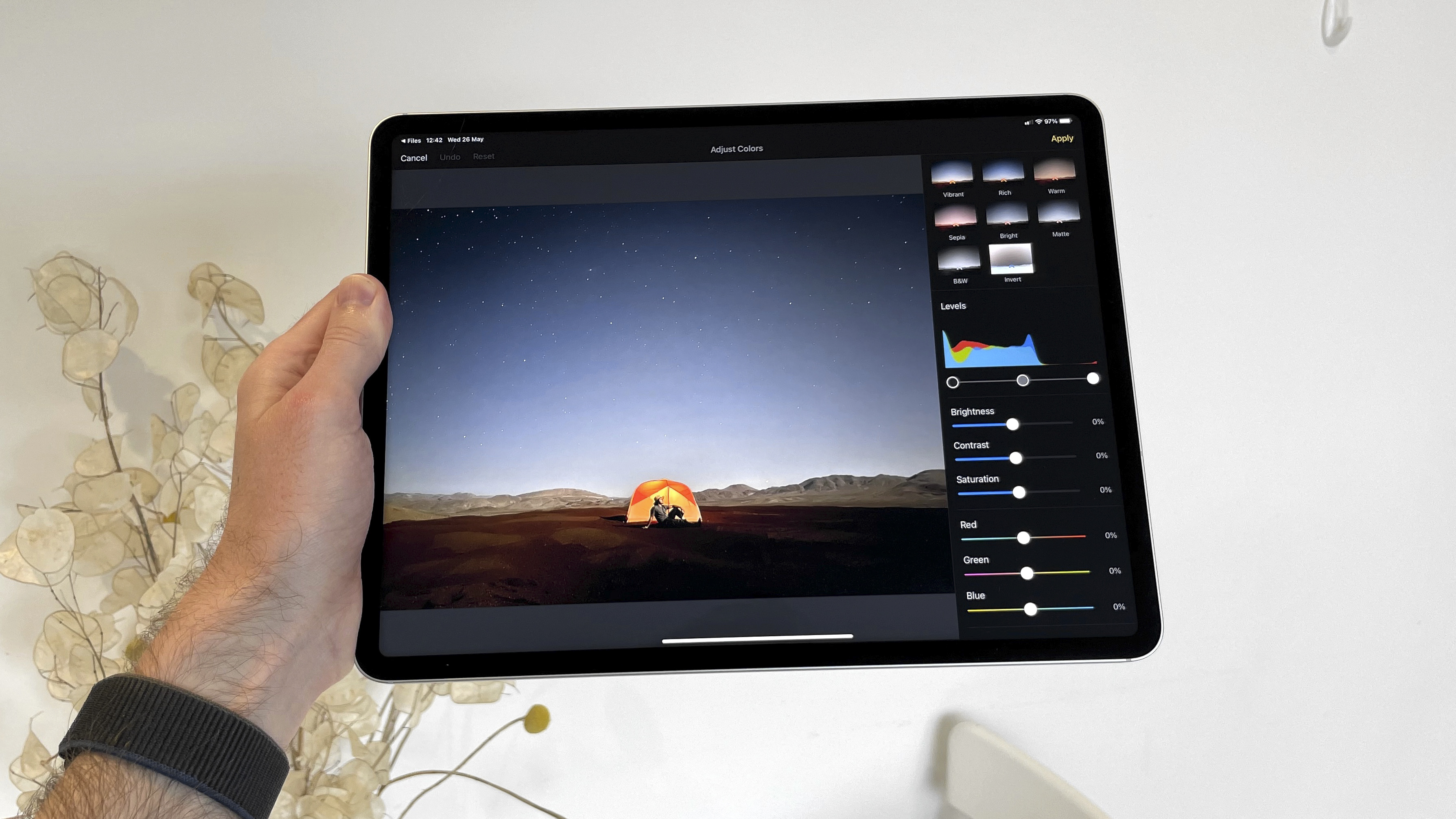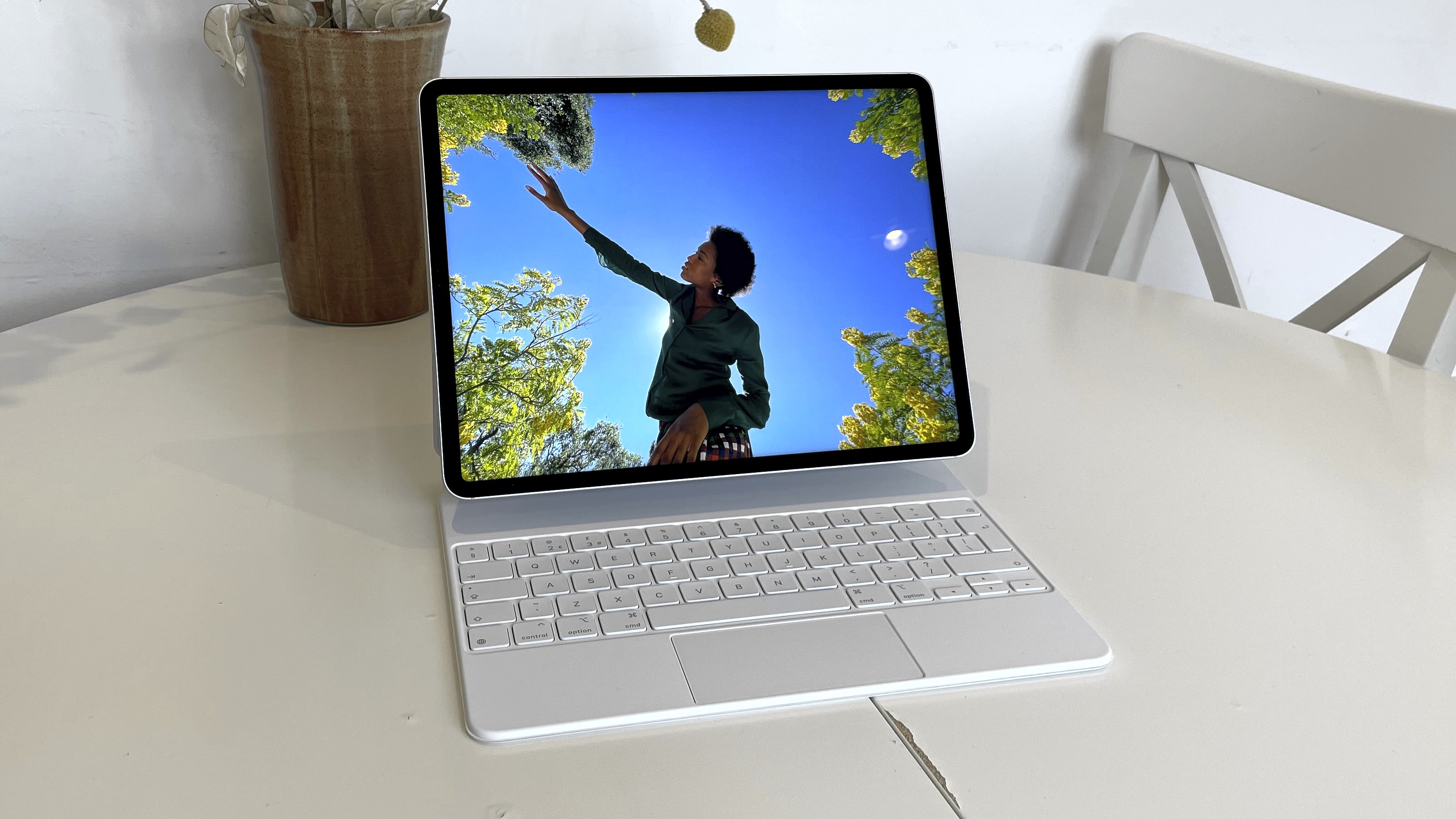Digital Camera World Verdict
The iPad Pro M1 is, simply, the best tablet you can buy. The screen is astounding, the M1 processor is truly a beast, and everything else is top-tier too. The only question is of value – whether you’ll make use of the new features, or whether Apple’s (excellent) cheaper tablets would serve you just as well. Because if money’s no object, this is clearly the peak of the tech currently.
Pros
- +
Amazing HDR Mini-LED screen
- +
Ridiculously powerful M1 chip
- +
Extremely thin and well-made
- +
Useful optional 5G connectivity
Cons
- -
Screen is mostly still 600 nits
- -
Just one port still
Why you can trust Digital Camera World
The 2021 iPad Pro 12.9 M1 looks almost identical to its predecessor, but there are several key changes that make it an especially interesting upgrade for photo and video work. A workstation-class processor, an ultra-bright HDR screen, a Thunderbolt 4 port for rapid file transfer, and the option of 5G connectivity – all in a slim and light body – combine to make it one of the most desirable ways to view and quickly process your photos - and one of the best tablets for photo editing overall.
It’s not just for photographers, though – it’s generally the best tablet overall, though it has a pro-level price to match its name, and the features that make it so expensive are totally overkill for most people. However, once you see that screen in particular, which uses cutting-edge Mini-LED technology, you still not not be able to resist.
Before we start, we should note that while we’ve tested the 12.9-inch model, everything in this review will apply to the 11-inch model too, with the exception of the Mini-LED HDR screen – we’ll talk about that difference in the ‘Screen’ section.
• iPad generations - which Apple tablet is best for me?
Key features

One of the two flashiest features here is the Apple M1 processor powering the iPad Pro – the same as in the new iMac and 13-inch MacBook Pro. If you buy the versions with 128GB, 256GB or 512GB of storage, you get 8GB of RAM. The versions with 1TB or 2TB of storage come with 16GB of RAM.
The other flashiest feature is the HDR display, which is capable of going much brighter than previous models, while also offering better control in dark areas.
There’s still a single USB Type-C port, but it’s now been upgraded to both USB 4 and Thunderbolt 4 – the latter makes it even more flexible for connecting to external storage, and when combined with internal storage that’s much faster, means big file transfers to and from the iPad are a cinch. It also means you can connect to displays of up to 6K resolution, which can be great for showing your images.
The best camera deals, reviews, product advice, and unmissable photography news, direct to your inbox!
The twin rear cameras haven’t been altered much, and you still get both a wide-angle and ultra-wide, but now with better processing from the more powerful M1 chip. The front camera is much-changed, however, with a new ultra-wide lens and Apple’s smart ‘Centre Stage’ technology for video calls, which keeps you centred in the frame even if you move around.
The basic version is Wi-Fi only, but you can choose a version that offers Wi-Fi plus 5G/4G connectivity, for an upgrade cost. We’ve measured download speeds of 300Mbps on our model, and uploads of up to 65Mbps up. If you’re in an area with coverage, this makes shooting, transferring to iPad, quickly editing and uploading to the cloud an incredibly fast experience.
You’re still talking 10 hours of battery life under normal use, though more intensive applications (and pushing the HDR screen to its limits) will certainly bring that down.
Screen
In normal use, the new iPad Pro’s screen hits 600 nits of brightness, just like the previous model, so in many apps, the difference is subtle. However, when viewing HDR video or HDR photos, it can step up to 1,000 nits of fullscreen brightness, and 1,600 nits of peak brightness in smaller sections.
This matches Apple’s Pro Display XDR computer monitor, and bests almost any pro-level monitor, actually. Especially when combined with over 2,500 individual dimming zones, thanks to the Mini-LED technology used in the display – again, this is better than you can get from almost any other screen.
It makes a massive difference with HDR video – the extra dynamic range is immediately clear, and the brightness makes for more vibrant and lifelike colors, and there is much more depth and detail in darker areas. It’s easily the best video viewing experience on a tablet. It’s better than most TVs for contrast, even.
However, it’s not necessarily that easy to trigger. Sure, for a movie in Dolby Vision on Netflix, it’s no problem. But HDR photos don’t have a set standard, so while the iPad is willing to show your photos with more brightness, it will be up to your image viewing/editing app of choice to support it. That applies to video you’ve recorded that you want to import to the iPad too – it might include enough information, but you’ll need to check if your workflow would actually support showing it all on the screen.
Even if you’re not using an app with support for the HDR screen, though, you still benefit from it, because of its better control over dark areas. Anything with greys or black areas near light areas will benefit from extra vibrancy in the white areas, because of the extra precision in the backlight dimming. It makes tool icons easier to spot, and generally is a noticeable improvement.
On top of this, you’ve got the same DCI P3 color gamut support and supreme out-of-the-box accuracy we’re used to from Apple, and the resolution of 2732x2048 (264 pixels per inch) looks beautifully sharp at usual viewing distances. Apple’s True Tone screen technology is also here, and makes the screen so much more comfortable to use for reading and similar tasks in the evening.
The 11-inch iPad Pro features all of these last features (though, being a smaller screen, its resolution is just 2388x1668). It’s the HDR features and better local dimming you miss out on.
Performance & cameras
As expected, the M1 processor in the iPad Pro means that it’s astoundingly fast at anything you want to do… but then, so was the previous model. There certainly are processes that the M1 could save you a lot of time on, such as speedier batch exports, but it will depend on your workflow whether the power here will actually improve things for you today.
Of course, one of the advantages of the M1 is that it has the power to handle anything you might want to do in the future, as the iPad becomes more and more capable (hopefully). However complex your image work, it should be able to stand up to it. And running multiple 4K video streams in an editing app is no trouble for it at all. If you want an iPad for work, this is just the most capable tool on the planet, and will remain so in the future. But for regular tablet use, it’s supremely overkill, no question.
The gentle upgrades to the rear cameras yield similarly gentle improvements. The iPad Pro 2021 takes nice photos, with good dynamic range, pleasing detail that isn’t oversharpened, and the mercifully realistic colors that Apple currently favors in its processing. It’s certainly not up to what the iPhone 12 Pro Max can do, and it’s a real shame there’s no ProRaw option, since there’s certainly enough power and RAM to handle it, but if you find yourself faced with a great shot, you can do far worse.
The forward-facing camera is interesting, because it’s now a 12MP camera, but is designed to mostly crop in from its ultra-wide view for a more narrow framing – it’s just that the wide view gives it the freedom to be flexible in this. The main beneficiary is video calling, using the new ‘Center Stage’ feature. This crops the view onto you, and if you move, the view moves with you. If someone else comes into shot, it reframes to get you both. It works incredibly well, and is a lovely feature to have in the age of numerous video chats.
Verdict
The iPad Pro M1 12.9-inch is simply excellent. It’s in a class of one. Nothing else offers this kind of screen, and this kind of performance, in this kind of portable frame. It is the premium tablet for creative pros that you’d want, and its price is thoroughly reasonable when you look at what a separate display with these features or a computer of this power would cost.
But it remains an iPad, using iPad apps, which not everyone is able to (or likes to) do all their work on, including photography work. And the M1 processor has more power than almost all iPad apps could even hope to make use of. So if you’re using it mostly as a regular tablet, it remains the best in the business, but do consider whether the 10.9in iPad Air (2020) actually would do the work you need for a lot less.
Read more
The best iPads for photo editing & video editing
Best cases for iPad Pro
Best iPad keyboard
Best stylus for iPads and iPhones
The best phablets: big-screen smartphones
The best monitors for photographers
Matthew is the editor of T3 magazine putting the best gadgets in ink every month, having worked across on many tech mags over the last decade.








